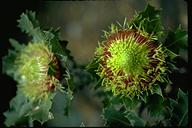

 |
Australian National Botanic Gardens
|
 |
A weekly news sheet prepared by a Gardens' volunteer.
Numbers in square brackets [] refer to garden bed Sections.
Plants in flower are in bold type.
13 January 2006
 |
|
Dryandra quercifolia - click for larger image |
The weekend Summer Concerts are on to a popular start… surrounded by flowering plants. In the car park see the magnificent trees, Angophora costata subsp. costata [Section 168], crowned with large clusters of white frilly flowers. Throughout the Gardens kangaroo paws leap out everywhere. They include Anigozanthos ‘Bush Glow’ [Section 174] with greenish-yellow ‘paw’ flowers on long bare stems, edging Banks Walk with the semi-prostrate Chrysocephalum apiculatum [Section 174], with yellow button flowers amid the grey foliage. There is also Eucalyptus albopurpurea [Section 174], an open small tree with pink fluffy flowers.
This next area includes Grevillea ‘Poorinda Royal Mantle’ [Section 124], a dense ground-cover which reveals its maroon toothbrush-like flowers. Babingtonia ‘Howies Feathertips’ [Section 124] is a medium dense shrub covered well with tiny white flowers and Babingtonia pluriflora ‘White Cascade’ [Section 124] has willowy branches also covered with white flowers. Between them is a yet small climber, Pandorea sp. [Section 124] with vivid pink trumpet flowers. Melaleuca ‘Hot Pink’ [Section 126] is an open shrub decorated with pink bottlebrush-like flowers.
 |
Angophora hispida - click for larger image |
In this next section of grasses the Blue Devil, Eryngium rostratum [Section 8] has cylindrical flower heads with electric blue spikes on bare branches. Close by, Xyris operculata [Section 8] a small grassy plant with yellow three-petalled flowers on upright stems. Above this grassy section is a most colourful grouping of kangaroo paws which include Anigoznthos ‘Bush Ruby’ [Sections 7,8], Anigozanthos ‘Bush Baby’ [Section,7,8] with yellowish flowers and Anigozanthos flavidus [Section 8] with soft green flowers. All are laden with nectar enjoyed by our honeyeating birds, just now the colourful Eastern Spinebills. Continuing, Dryandra quercifolia [Section 30] is yet small and dense with sharp holly-like leaves many reddish buds maturing to large yellow flower heads. Opposite, Banksia ‘Birthday Candles’ [Section 30] is a dwarf spreading plant laden with juvenile pencil thick green flower spikes. Down the next right path, Chittick, Lambertia inermis [Section 27] is a large shrub bright with well arranged orange tubular flowers. Lower down, Swamp banksia, Banksia robur [Section 28], is bearing its bottle green flower spikes amid its large leathery leaves, green on some plants and with red veins on others. Returning to the former path Banksia caleyi [Section 24] is small and spreading with maroon pendent flower spikes.
Edging the Eucalyptus Lawn side of the Sydney Basin, scaevolas include Scaevola ramosissima [Section 191H], presenting deep purple fan-shaped flowers along the trailing stems. Actinotus ‘Star Bright’ [Section 191H] bears its white flannel flowers amid its velvety foliage and Coopernookia barbata [Section 191H] is a dense herb with an abundance of pink flowers. The Fringed lily, Thysanotus tuberosus [Section 191H] has purple fringed three-petalled flowers with grass-like leaves. Returning hopefully, Dwarf Apple, Angophora hispida [Section 22] continues to be laden with large white flower clusters from the large lateral branches.
Flowers, flowers, beautiful flowers … Barbara Daly.